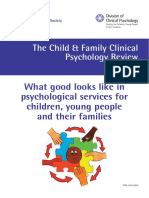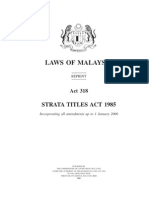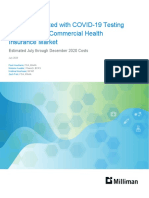0 ratings0% found this document useful (0 votes)
13 viewsMuseology Notes
Museology Notes
Uploaded by
Baishali BhattacharyaCopyright:
© All Rights Reserved
Available Formats
Download as DOCX, PDF, TXT or read online from Scribd
Museology Notes
Museology Notes
Uploaded by
Baishali Bhattacharya0 ratings0% found this document useful (0 votes)
13 views4 pagesOriginal Title
museology notes
Copyright
© © All Rights Reserved
Available Formats
DOCX, PDF, TXT or read online from Scribd
Share this document
Did you find this document useful?
Is this content inappropriate?
Copyright:
© All Rights Reserved
Available Formats
Download as DOCX, PDF, TXT or read online from Scribd
Download as docx, pdf, or txt
0 ratings0% found this document useful (0 votes)
13 views4 pagesMuseology Notes
Museology Notes
Uploaded by
Baishali BhattacharyaCopyright:
© All Rights Reserved
Available Formats
Download as DOCX, PDF, TXT or read online from Scribd
Download as docx, pdf, or txt
You are on page 1of 4
BRIEF REPORT ON MUSEUM VISIT
State Archaeological Museum, Alipore Museum ,1st
December: Yesterday the Department of History Bethune
College arranged an educational tour for us, the students of
semester 3. The tour was generally conducted for our SEC
paper of the CBCS examination. In the morning all the
professors of our department went to visit the two museums
that is State Archaeological Museum in Behala and Alipore
Jail Museum in Alipore. First, we went to State Museum
where we found the following gallaries.1)sites and
sights.2)Paintings of Bengal 3)Sculptures of
Bengal,4)Jagjivanpur,West Bengal in early historic period.
There were also pre-history, proto history, ethnic art and
numismatics, coinage in Bengal. After that we went to
Alipore jail Museum where history came alive to us. There we
visited the various cells of the various freedom fighters of
India and also in the gallow where we had goosebumps. We
felt like we went back to those days. To give detailed
information about the museum first we will start with State
Archaeological Museum.
State Archaeological Museum was inaugurated by the
then chief minister of West Bengal Honorable Jyoti Basu in
1980 and it contains 5 galleries which are sites and sights,
paintings of Bengal, sculptures of Bengal, Jagjivanpur
Excavation and West Bengal Early Historic Period. There is
also pre-history, proto -history, ethnic art, numismatics and
coinage of Bengal.
In the first gallery we saw rich artistic heritage of Bengal,
general view of susunia hill, Neolithic site in Kalimpong,
paleolithic implements in sukarnarekha,photos of
excavations of Pandu Rajar Dhipi(1961-62),Baneswar
Danga(1974) and also Late Paresh Chandra Dasgupta
excavating a skull from the site. Terracotta figures from
Chndraketugarh, Bangarh(Ist to 6th century BCE), large brick
from Gupta Period, discovered from Jalpaiguri District,
photos of excavated citadel from Bangarh ,Dakshin Dinajpur,
excavated temple complex from Rajbadidanga in
Murshidabad. Dated 10th to 12thcen and excavated stupa
from Burdwan District.
In the galleries of paintings of Bengal we saw Durga the
Mahishashur Mardini of Krishnanagar, Mahabidya soroshi of
Hugli,Radhar Manbhonjon , sitar porinoy,Binodoni of Kalighat
style and women with roses, an old lady found from Bankura
and Jamini Roys picture etc.
In the gallery of sculptures of Bengal we saw Mahishashur
Mardini from 11th century,tugisahar of Gaud Malda,
Chamunda in uttar Dinajpur,miniature jain temple at Panihati
, tirthankara shantinatha at Medinipur District.Ombika at
Bankura,Dakshin Dinajpur.There were also excavation at
Hatpara where we found bangles,terracotta lamps
etc.Hatpara is located in the Murshidabad district .By
excavating the sites the items archaeologists found were
colourful glass bangles, terracotta rattels and terracotta
lamps,terracotta dabber.Through the site excavation the
history of human habitation has pushed back to almost
40,000 years ago.But the state archaeological museum has
kept only those items which dated back to sultanate period
which is 14th or 15th century.
In the gallery of Jagjivanpur excavation we saw discovery of
copper plates and five major mounds Akshidanga, Maibhita
etc. This village was the eastern fringe of Malda District
adjacent to Indo Bangladesh Border to find an important
place in the archaeological map of Bengal.We got to know
that Pala king Mahendrapala son and successor of Devapala
granted pieces of lands in this area for building a monastery.
In the gallery of sculptures we saw Trimatrika by
Birabhadra from uttar Dinajpur.Important sites were
Deulbari,moynamoti paharpur and also some areas of
Himalayan region.
In the gallery of Early Historic period we saw narratives
and social scenes,seals and sealings, metals and
coins,animals and birds, sculptures of mother
goddess ,designed pottery ,artefacts etc.
There was also a Bus museum where we saw terracotta
artefacts from Post Gupta period and coins from the Mughal
Period.
ALIPORE JAIL MUSEUM : The Alipore central jail earlier seved
as a correctional home until 2019 when all its inhabitants
were shifted o Baruipur and it was declared as a Heritage site
located at the heart of Calcutta.This building is 117 years old
and brick red colour is one of its prominent feature.From
being silent witness to the brutalities inflicted upon the
freedom fighters of the country the Alipore correctional
home is now transformed as a memorial and museum to
honor for those who sacrificed their lives for the
independence of India.
Alipore jail museum also consists of gallows, special cells,
seminar hall and a library and a light and sound show
exhibitions (one in cell 5 and hospital building).Netaji
Subhash Chandra Bose, Rishi Aurobindo,Bidhan Chandra Roy,
Jawaharlal Nehru were among the prominent national figures
who were arrested and kept here.Along with these
prominent figures we come to know about women martyrs
of Bengal.Here we get a brief knowledge of women freedom
fighters like Bina Das , Matangini Hazra etc.
CONCLUSION
In fine it can be concluded that both the places were
extremely informative and it boosted our natural learning
and gave us first habd and wonderful experience.
You might also like
- Telhara (Nalanda) Excavation ReportDocument2 pagesTelhara (Nalanda) Excavation ReportNiraj Kumar0% (1)
- Customer Pyramid: A Proven CRM StrategyDocument6 pagesCustomer Pyramid: A Proven CRM StrategyRolandas Medžiūnas50% (2)
- Indian Museum ReportDocument3 pagesIndian Museum Reportluckyagarwal.ra56No ratings yet
- Yahoomai - CM Assignment: Topic: A Visit To TaxilaDocument10 pagesYahoomai - CM Assignment: Topic: A Visit To TaxilaIzhaŕ ĶẳsìNo ratings yet
- Archaeological Sites in TaxilaDocument5 pagesArchaeological Sites in TaxilaLaraibmalik 674No ratings yet
- Deccan College Museums Archaeology Museums GalleriesDocument2 pagesDeccan College Museums Archaeology Museums GalleriesVenugopal Balakrishnan NairNo ratings yet
- 1493295681P15 M31 NationalMuseum NewDelhi ETDocument14 pages1493295681P15 M31 NationalMuseum NewDelhi ETkartikeybagdi7No ratings yet
- National Museum: By: Kushal (MBA Devvrat (NPGD-33)Document25 pagesNational Museum: By: Kushal (MBA Devvrat (NPGD-33)Mukesh SharmaNo ratings yet
- Museums in BiharDocument14 pagesMuseums in BiharAmit SinghNo ratings yet
- Assignment On Archelogy in BangladeshDocument7 pagesAssignment On Archelogy in BangladeshAldrich Theo MartinNo ratings yet
- HERITAGE Report Bharat Itihas Sanshodhak MandalDocument14 pagesHERITAGE Report Bharat Itihas Sanshodhak MandalNikki NikkiNo ratings yet
- 5 Great Museums in IndonesiaDocument3 pages5 Great Museums in IndonesiaavdulrojaqNo ratings yet
- Wa0000Document12 pagesWa0000sk7575442No ratings yet
- Art CultutreDocument33 pagesArt CultutreSona SunilNo ratings yet
- Chandigarh MuseumDocument2 pagesChandigarh MuseumAshu AgarwalNo ratings yet
- A Voyage Through TimeDocument20 pagesA Voyage Through TimeMuskan SinghNo ratings yet
- Short History Notes For EPFO SSADocument2 pagesShort History Notes For EPFO SSAnivedithaumapathi84No ratings yet
- Museum - Salar JungDocument8 pagesMuseum - Salar JungT Sampath KumaranNo ratings yet
- Ahsin Shah Updated Synopsis 2 03 2021Document10 pagesAhsin Shah Updated Synopsis 2 03 2021RohailNo ratings yet
- Stone AgeDocument3 pagesStone Agerashiamazing27No ratings yet
- Museum of Tribal HeritageDocument5 pagesMuseum of Tribal HeritageShalvi SharmaNo ratings yet
- Ancient Terracotta Art of West BengalDocument48 pagesAncient Terracotta Art of West BengalFarhan AbsarNo ratings yet
- Presentation 1Document2 pagesPresentation 1ayush kushwahNo ratings yet
- Work Art and Culture NotesDocument127 pagesWork Art and Culture NotesAasif Ahmad SheikhNo ratings yet
- Art & CultureDocument141 pagesArt & CultureMullapudi Sriganesh100% (1)
- History CultureDocument96 pagesHistory CultureAnshuman SinghNo ratings yet
- Jajpur Chapter 3Document39 pagesJajpur Chapter 3S.s. MichaelNo ratings yet
- A Visit To A MuseumDocument1 pageA Visit To A MuseumFaiza HussainNo ratings yet
- Passing Sight Museum Nasional Copy-2Document2 pagesPassing Sight Museum Nasional Copy-2Nazwa VyraNo ratings yet
- Asia and The Lights CivilizationsDocument8 pagesAsia and The Lights CivilizationsLai Jing Hao 歪歪No ratings yet
- The Story of The Stupa - LonghurstDocument105 pagesThe Story of The Stupa - Longhurstkyawsoe htunNo ratings yet
- 18LEM110L-Indian Art Form: Semester - ViDocument12 pages18LEM110L-Indian Art Form: Semester - Viuditiverma24No ratings yet
- It Was Opened in 1996 in Honor of The 660th Anniversary of The BirthDocument2 pagesIt Was Opened in 1996 in Honor of The 660th Anniversary of The BirthAbdulboqiy AmrullayevNo ratings yet
- Principles of Archaeology (2 Marks)Document6 pagesPrinciples of Archaeology (2 Marks)sashaalfredmurrayNo ratings yet
- Wa0001Document16 pagesWa0001aaravkumar.av000No ratings yet
- Block-I: StructureDocument45 pagesBlock-I: StructureNataraj NataNo ratings yet
- Current Affairs AC - 1710837655Document33 pagesCurrent Affairs AC - 1710837655hrsiemenshrNo ratings yet
- Ias Network 2023 Art and Culture Notes PDFDocument131 pagesIas Network 2023 Art and Culture Notes PDFRam JesusNo ratings yet
- Sidra Shaikh RP History of Early India Buddhist Caves of Early IndiaDocument4 pagesSidra Shaikh RP History of Early India Buddhist Caves of Early Indiasidrashakirshaikh9No ratings yet
- FNA - 143 Unit 1 (Bhimbetka Caves)Document28 pagesFNA - 143 Unit 1 (Bhimbetka Caves)Tamanna 11th Non MedNo ratings yet
- Ancient History TN Class 6Document24 pagesAncient History TN Class 6M Teja100% (1)
- Unit 5 - ITCSDocument24 pagesUnit 5 - ITCSAnjani KumariNo ratings yet
- Class-6, L-11, HistoryDocument5 pagesClass-6, L-11, Historyshabnam.humancapitalNo ratings yet
- 1493295681P15 M31 NationalMuseum NewDelhi ETDocument14 pages1493295681P15 M31 NationalMuseum NewDelhi ETkartikeybagdi7No ratings yet
- EVS Report On India Shell Museu1Document5 pagesEVS Report On India Shell Museu1vinayavinod1212No ratings yet
- Museums of Archaeological Survey of IndiaDocument2 pagesMuseums of Archaeological Survey of IndiaGagan Theroyal0% (1)
- Tribal Museum Case StudyDocument6 pagesTribal Museum Case Studyjanani paulraj100% (1)
- FTCP - Ancient C-7:1Document5 pagesFTCP - Ancient C-7:1cgs.jnu14No ratings yet
- Back To The Ages PDFDocument5 pagesBack To The Ages PDFShafi PKNo ratings yet
- 24 Prehistoric Era Art - Rock Paintings (Indian Culture Series - NCERT) PDFDocument4 pages24 Prehistoric Era Art - Rock Paintings (Indian Culture Series - NCERT) PDFsarawalem1100% (1)
- Art & Culture Prelims Revision PDFDocument328 pagesArt & Culture Prelims Revision PDFmanojNo ratings yet
- History and CivicsDocument28 pagesHistory and Civicsgaming with skimiNo ratings yet
- Art and Culture Lecture 6Document35 pagesArt and Culture Lecture 6aditya guptaNo ratings yet
- Archaeological Museums of PakistanDocument16 pagesArchaeological Museums of PakistanAsim LaghariNo ratings yet
- Untitled PresentationDocument9 pagesUntitled Presentationrabia wahidNo ratings yet
- Monuments, Objects, Histories: Institutions of Art in Colonial and Post-Colonial IndiaFrom EverandMonuments, Objects, Histories: Institutions of Art in Colonial and Post-Colonial IndiaNo ratings yet
- Glimpses of Karnataka and Sample Itinerary: Pictorial Travelogue, #5From EverandGlimpses of Karnataka and Sample Itinerary: Pictorial Travelogue, #5No ratings yet
- Aria Melinda Luisa R. Lariosa: OBJECTIVE:: Seeking A Challenging Career ThatDocument3 pagesAria Melinda Luisa R. Lariosa: OBJECTIVE:: Seeking A Challenging Career ThatryuggaNo ratings yet
- Assignment in SociologyDocument2 pagesAssignment in SociologyElissa PagulayanNo ratings yet
- Pronombresobjetoe1 EXAMEN INGLES PDFDocument2 pagesPronombresobjetoe1 EXAMEN INGLES PDFAna Maria Cadenas GuerreroNo ratings yet
- Recertification - Acronis #CyberFit Cloud Tech FundamentalsDocument78 pagesRecertification - Acronis #CyberFit Cloud Tech FundamentalsFalcon NogueraNo ratings yet
- 0 - Zone Brewery Support Handbook v02 2017Document130 pages0 - Zone Brewery Support Handbook v02 2017edward contrerasNo ratings yet
- Ezekiel and The LandDocument29 pagesEzekiel and The Landloveland22No ratings yet
- 6 CH First Empire SM 4Document16 pages6 CH First Empire SM 4kundu_mrNo ratings yet
- RICHLEERESEARCHMAKAGWAPA2Document8 pagesRICHLEERESEARCHMAKAGWAPA2bibibebebaby leeleeNo ratings yet
- CFCPR 3 PDFDocument168 pagesCFCPR 3 PDFece142No ratings yet
- FDP ReportDocument14 pagesFDP ReportdipuNo ratings yet
- Study On Social Media Marketing of Amazon..............................Document15 pagesStudy On Social Media Marketing of Amazon..............................Sunil KumarNo ratings yet
- Kashato Shirts - SolutionsDocument18 pagesKashato Shirts - SolutionsAldrian Ala75% (4)
- Collocations and Exercises With Do, Have, Make and Take For FCEDocument3 pagesCollocations and Exercises With Do, Have, Make and Take For FCEzvegaNo ratings yet
- Strata Titles Act 1985Document118 pagesStrata Titles Act 1985leechin8350No ratings yet
- Jane Austen Art of CharacterizationDocument4 pagesJane Austen Art of CharacterizationSara SyedNo ratings yet
- Mass Media For Health Communication andDocument11 pagesMass Media For Health Communication andsofia mubasherNo ratings yet
- Justin Bieber MistletoeDocument4 pagesJustin Bieber MistletoeMusic EducationNo ratings yet
- Student DiversityDocument49 pagesStudent DiversityBhaskar TupteNo ratings yet
- Extintores Badger Certificacion Ul Polvo Quimico Seco PDFDocument3 pagesExtintores Badger Certificacion Ul Polvo Quimico Seco PDFEliud RodriguezNo ratings yet
- May 2020Document4 pagesMay 2020camachoyadira72No ratings yet
- Entrepreneurship Final ModulesDocument179 pagesEntrepreneurship Final Moduleseden gebetaNo ratings yet
- Vetting and Screening PolicyDocument22 pagesVetting and Screening PolicyRohan NNo ratings yet
- Ashtakavarga AnalysisDocument2 pagesAshtakavarga AnalysisShashikant Madkaiker0% (1)
- COVID-19 Testing Report FinalDocument25 pagesCOVID-19 Testing Report FinalNick ReismanNo ratings yet
- DraculaDocument2 pagesDraculajoancanalNo ratings yet
- Stw45Nm60: N-Channel 650V@Tjmax - 0.09 - 45A - To-247 Mdmesh™ Power MosfetDocument12 pagesStw45Nm60: N-Channel 650V@Tjmax - 0.09 - 45A - To-247 Mdmesh™ Power MosfetYani RiyaniNo ratings yet
- Strong and Weak Forms Practice + KeyDocument3 pagesStrong and Weak Forms Practice + KeyMarco Michienzi100% (2)
- Revenue Cycle AuditDocument5 pagesRevenue Cycle Auditandi TenriNo ratings yet
- Unit 3Document328 pagesUnit 35pkw48m27cNo ratings yet

























































































